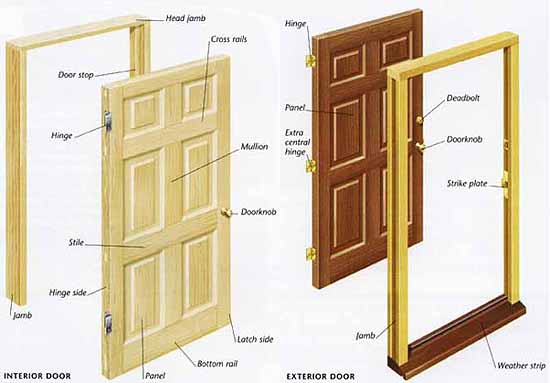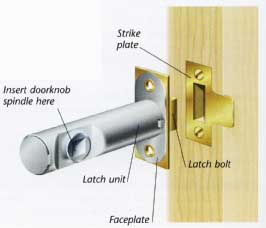The way pre-hung doors are installed is similar in both entry door and interior door applications. Entry doors are generally heavier and wider than interior doors. Most interior doors are 2 ft. 6 in. (750 mm) and entry doors are typically 3 ft. (900 mm). When a standard-sized door is being replaced, the new door will fit in the same place as the old one. When putting in a new entry door, the frame should be aligned with the external skin of the wall and then recessed inside the exterior wall surface.
Choosing Size and Number of Hinges
Once quality and finish have been decided, the number and size of the hinges required relates directly to the weight and function of the door. Interior doors may have two or three hinges. A third hinge, positioned centrally, may be necessary for heavy interior doors. A minimum of three or four hinges are used on entry doors. Large hinges with four or more fastener holes are normally used on entry rather than interior doors. Also, remember that hinges should be oiled after installing (they rarely come ready-oiled). Finally, if a hinge is used on a fire door, make sure that it has the required resistance rating (for fire doors click here).

Interior Door: Door stop; Hinge; Stile; Hinge side;
Mullion; Doorknob; Latch side; Head jamb; Cross rails; Bottom rail. Exterior
Door: Weather strip; Deadbolt
Locks and Latches
Doors normally require a latch mechanism so that they can be securely closed. Interior doors tend to have a simple mortise catch. The main body of the latch is attached to the closing edge of the door. The catch then engages with a plate that's attached to the door jamb or door frame.
Entry doors and many interior doors may also have door locks for security reasons or just privacy within a home. Common types of door locks include mortise lock sets, cylinder and tubular locks, and unit locks. Cylinder locks are most common in residential use. Deadbolts are used in addition to a standard doorknob lock on entry doors. When selecting door hardware, it's important to know which way the doors swing.

Passage latch: Used on interior doors where security isn't an issue. The latch is opened as the handle is turned. Insert
doorknob spindle here.